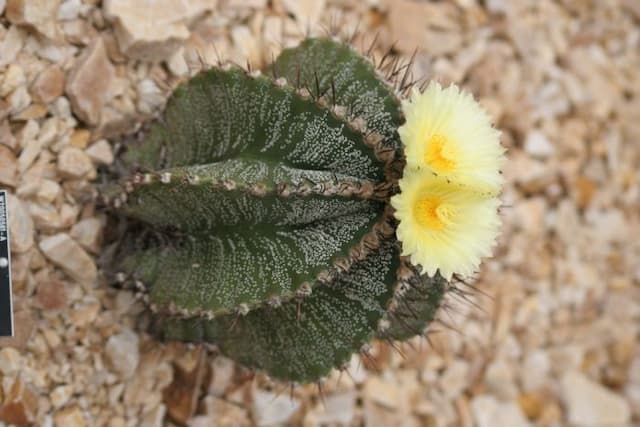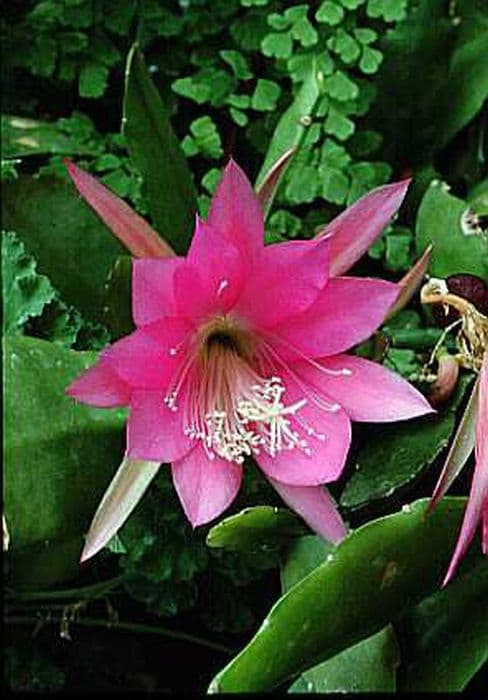Old Lady Cactus Mammillaria hahniana

ABOUT
The Old Lady Cactus, popularly known by its charming name, is a species that boasts a spherical or slightly elongated shape. True to its nickname, it has a dense covering of white hair-like spines that resemble the wispy hair of an elderly woman. Radiating appeal, the fluffy white hairs provide a striking contrast against the dark green body of the cactus, enhancing its overall charm. Encircling the body of the Old Lady Cactus are pronounced tubercles or bumps that give it a fascinating texture. From the axils of these tubercles emerge the dense, white spines, which further contribute to the plant's fluffy appearance. Accentuating this woolly ensemble, the Old Lady Cactus bursts into life with a crown of brilliant pink or purple flowers that encircle the top of the cactus like a colorful halo. These flowers are a dazzling display that adds to the visual allure of this attractive plant. Though the size is not the focus here, the dimensions of the Old Lady Cactus are modest, making it a favored choice for collectors and enthusiasts who appreciate its small stature and ease of care in a container setting. The flowers against the green and white backdrop make it not only a point of botanical interest but also a favorite ornamental houseplant.
About this plant
 Names
NamesFamily
Cactaceae
Synonyms
Old Lady Cactus, Old Lady Pincushion, Birthday Cake Cactus
Common names
Mammillaria hahniana subsp. woodsii, Mammillaria hahniana var. albiflora, Mammillaria woodsii, Neomammillaria hahniana, Chilita hahniana, Ebnerella hahniana.
 Toxicity
ToxicityTo humans
The Old Lady Cactus (Mammillaria hahniana) is not known to be toxic to humans. There are no common reports of poisoning from ingestion of this plant. However, handling can cause physical irritation due to its spines, so it is advisable to be cautious when handling to avoid any prickles or skin irritation.
To pets
The Old Lady Cactus (Mammillaria hahniana) is not considered toxic to pets, and there are no widely reported cases of poisoning in animals such as cats and dogs from ingesting this plant. However, the spines can cause physical injury if a pet attempts to bite or swallow the plant, potentially leading to mouth or throat irritation or injury. It is recommended to keep the plant out of reach to prevent accidental injury.
 Characteristics
CharacteristicsLife cycle
Perennials
Foliage type
Evergreen
Color of leaves
Green
Flower color
Pink
Height
0.5 feet (15 cm)
Spread
0.5 feet (15 cm)
Plant type
Cactus
Hardiness zones
9
Native area
Mexico
Benefits
 General Benefits
General Benefits- Low Maintenance: Mammillaria hahniana, commonly known as the Old Lady Cactus, does not require frequent watering, making it suitable for busy individuals or those new to gardening.
- Drought Tolerant: The Old Lady Cactus is highly adapted to survive with minimal water, making it ideal for arid climates and water-conserving gardens.
- Decorative Appeal: With its dense covering of white spines and pink flowers, the Old Lady Cactus adds aesthetic value to any collection or as a standalone display.
- Easy to Propagate: This cactus can easily be propagated from offsets or seeds, allowing enthusiasts to expand their collection or share with friends.
- Compact Size: As a relatively small cactus, the Old Lady Cactus is perfect for indoor spaces, windowsills, and terrariums where space is limited.
- Pest Resistant: The Old Lady Cactus is resistant to most pests, reducing the need for chemical treatments and making it a more sustainable choice for home gardens.
- Long-Lived: Cacti in general, including the Old Lady Cactus, have a long lifespan, providing many years of enjoyment with proper care.
- Seasonal Interest: The Old Lady Cactus blooms with striking pink flowers, typically in the spring, offering seasonal interest and contrast to other foliage.
- Educational Value: Growing the Old Lady Cactus can teach about desert plants, survival adaptations, and botany, making it a valuable educational tool.
- Flexible Habitat: This cactus species can thrive indoors under the right conditions, and outdoors in warm, dry climate zones, offering flexibility for gardeners.
 Medical Properties
Medical PropertiesThis plant is not used for medical purposes.
 Air-purifying Qualities
Air-purifying QualitiesThis plant is not specifically known for air purifying qualities.
 Other Uses
Other Uses- Photography Prop: Mammillaria hahniana, also known as the Old Lady Cactus, can be used as an attractive photography prop due to its distinctive woolly appearance, adding a touch of natural beauty to the composition.
- Education: Researchers and educators use the Old Lady Cactus as a living example to teach about cacti adaptation, survival strategies in arid environments, and biodiversity.
- Artistic Inspiration: The unique spherical shape and dense spines of the Old Lady Cactus have inspired artists and crafters to create paintings, sculptures, and various arts and crafts.
- Feng Shui: In Feng Shui, the Old Lady Cactus is thought to add energy to a home by absorbing negative vibes, minus its pointed spines which are generally considered inauspicious.
- Thematic Gardens: Collectors and enthusiasts may include the Old Lady Cactus in desert-themed landscapes or miniature fairy gardens due to its small size and intriguing texture.
- Gift Plant: The Old Lady Cactus, with its low maintenance needs and appealing look, serves as a popular gift for plant enthusiasts or as a housewarming present.
- Jewelry Holders: Some people use the compact size and shape of the Old Lady Cactus to drape small pieces of jewelry like rings or lightweight bracelets over its spines.
- Fashion Design: The texture and form of the Old Lady Cactus can serve as creative inspiration for fashion designers seeking to create nature-inspired textiles and patterns.
- Nature Crafts: Dried flowers or spines from the Old Lady Cactus can be incorporated into homemade craft projects, such as making bookmarks, greeting cards, or decorative boxes.
- Seasonal Decoration: During certain holidays, plant enthusiasts sometimes decorate the Old Lady Cactus with miniature festive ornaments, turning it into a living seasonal display.
Interesting Facts
 Feng Shui
Feng ShuiThe Old Lady Cactus is not used in Feng Shui practice.
 Zodiac Sign Compitability
Zodiac Sign CompitabilityThe Old Lady Cactus is not used in astrology practice.
 Plant Symbolism
Plant Symbolism- Endurance: The Mammillaria hahniana, commonly known as the Old Lady Cactus, is a symbol of endurance due to its ability to thrive in desert climates and persist through tough conditions.
- Protection: With its densely packed spines, the Old Lady Cactus represents protection, as these spines guard the plant against herbivores in the wild.
- Self-Reliance: This cactus is often seen as a symbol of self-reliance because it is well-adapted to survive on minimal water and resources.
- Beauty and Longevity: The pink or purple flowers of the Old Lady Cactus symbolize beauty and longevity, as they bloom even in harsh environments.
- Resilience: The Old Lady Cactus exemplifies resilience, as it can bounce back and continue to grow even after experiencing difficult conditions or damage.
 Water
WaterThe Old Lady Cactus, commonly known as Mammillaria hahniana, should be watered sparingly, as it's susceptible to over-watering. During the growing season, typically spring and summer, water the plant once every week with approximately 4 ounces of water or until the soil is completely moist but not waterlogged. In fall and winter, reduce watering to once every three to four weeks, allowing the soil to dry out completely between waterings. Always check that the pot has adequate drainage to prevent water accumulation at the bottom.
 Light
LightThe Old Lady Cactus prefers bright, indirect sunlight to thrive. It can tolerate direct sunlight in the morning but should be protected from the harsh afternoon sun. The ideal spot for this plant is a south or east-facing window where it receives plenty of light without the risk of scorching its delicate spines and flesh.
 Temperature
TemperatureThe Old Lady Cactus does well in temperatures between 70°F to 80°F during its growing season. It can survive minimum temperatures down to 40°F, making it suitable for most indoor environments. However, to stimulate dormancy, cooler winter temperatures between 50°F to 60°F are beneficial.
 Pruning
PruningPruning of the Old Lady Cactus is generally not required due to its slow growth and compact form. If necessary, pruning can be done to remove any dead or damaged spines, using tweezers or a soft brush to avoid injury. The best time for this minor pruning is in the spring before new growth begins.
 Cleaning
CleaningAs needed
 Soil
SoilThe Old Lady Cactus prefers a well-draining soil mix, typically one part potting soil mixed with one part perlite or pumice. Aim for a soil pH between 6.0 and 7.5.
 Repotting
RepottingThe Old Lady Cactus should be repotted every two to three years to refresh the soil and accommodate root growth, usually during spring or summer.
 Humidity & Misting
Humidity & MistingThe Old Lady Cactus thrives in low to moderate humidity levels, mimicking its native desert environment.
 Suitable locations
Suitable locationsIndoor
Place in bright light, away from drafts, water sparingly.
Outdoor
Needs full sun, shelter from rain, and excellent drainage.
Hardiness zone
9-11 USDA
 Life cycle
Life cycleThe old lady cactus (Mammillaria hahniana) begins its life as a seed, which, when provided with the right warm and moist conditions, will germinate. After germination, the seedling develops into a small cactus with a spherical shape covered in wool and spines. It enters a juvenile stage, where it grows slowly, forming offsets, and can start to flower between two and six years of age, depending on conditions. The flowering stage occurs annually, with pink-purple flowers appearing around the crown of the cactus, typically during the spring and summer months. After pollination, often by insects, the plant may produce small, club-shaped fruits that contain seeds, thus completing its reproductive cycle. Throughout its life, which can last for several decades, the old lady cactus remains a slow-growing plant, needing periods of dormancy in winter to sustain healthy growth and flowering.
 Propogation
PropogationPropogation time
Spring-Early Summer
The ideal propagation time for the Old Lady Cactus, also known as Mammillaria hahniana, is during the spring and summer months when the plant is actively growing. The most popular method of propagation is through offsets, which are the small clones that form at the base of the parent plant. To propagate by offsets, one should gently remove an offset that has formed roots from the main plant with a clean, sharp knife or by gently twisting it off by hand. Then, allow the offset to callous over for a few days in a warm, dry location. Once the cut has healed, plant the offset in a well-draining cactus soil mix. The container should be about 3-4 inches (7.6-10.2 cm) in size to accommodate the root system and provide space for growth. Water the newly planted offset sparingly to prevent root rot, and it will soon establish itself as a new plant.









